Oftentimes I am asked which is your favorite method of tempering or pre- crystallizing chocolate couverture. My answer is always the same: The cocoa butter method. Using cocoa butter to temper or pre- crystallize chocolate couverture is fast, hygienic and provides a finished result with high fluidity. Three factors which are very important.
If you are somewhat unclear on why we have to temper or pre-crystallize chocolate, or what chocolate couverture is in the first place, you may find it useful to read the other articles and methods of pre-crystallizing or tempering chocolate I have on my site. In a nutshell, when chocolate is melted and then properly pre-crystallized, it will harden with a crisp snap, it will easily retract from a mold and it will have a beautiful gloss. Without the pre-crystallization process it will be dull, grayish streaked, crumbly, stick to molds and will not be crisp.
Several types of cocoa butter products are on the market specifically made to be used for pre-crystallizing chocolate couverture. Since I had a hard time with these products clumping and not properly melting into the couverture, I decided years ago, to use and test standard cocoa butter for the tempering process. And my results are the exact same as using a specific cocoa butter product engineered for pre-crystallizing or tempering chocolate couverture. Using a micro plane and cocoa butter is all I use for quick, reliable tempering of chocolate. The cocoa butter I use is made by Callebaut.
What I like about the cocoa butter method the most:
1. Even though 1% of cocoa butter will properly pre- crystallize the couverture, adding more will not have any negative effects on the finished products. In fact, adding a little more will allow you to use the tempered chocolate at a higher temperature.
2. The chocolate couverture will be more fluid if compared to any other method of tempering. (Testing performed using the same brand at same temperatures)
3. Unless if using a tempering machine, it is the fastest method.
Just in case……couverture chocolate is what we need when tempering or pre-crystallizing chocolate. Couverture chocolate contains a minimum of 31% cocoa butter (Do not confuse cocoa butter with the % number of cocoa mass you see on chocolate bars- such as 64% cocoa mass etc), this amount of cocoa butter ensures a product which will be relative fluid when in a tempered state. Non couverture chocolate (think of standard chocolate chips) does not contain enough cocoa butter and will be a viscous mess when melted or pre-crystallized.
Tempering or pre-crystallizing chocolate couverture using cocoa butter.
You will need 1 % of cocoa butter to pre-crystallize or temper the chocolate couverture. For example to every 2lb 3 oz (1 kg) of chocolate couverture you will add 1 % (1/3 oz or 10 gram) cocoa butter.
Melt the chocolate to 115°F (46°C) over a very low simmering water bath (Bain Marie) or overnight in a chocolate melter. Let the chocolate cool to 95°F (35°C) for dark chocolate and 93°F (33.5°C) for milk and white chocolate.
2. Immediately add 1 % micro planed cocoa butter. Stir to dissolve the cocoa butter and homogenize the mass.
3. Let the chocolate cool to 90°F (31.5°C) for dark chocolate. For white and milk chocolate allow the chocolate to cool to 87°F (29.5°C)

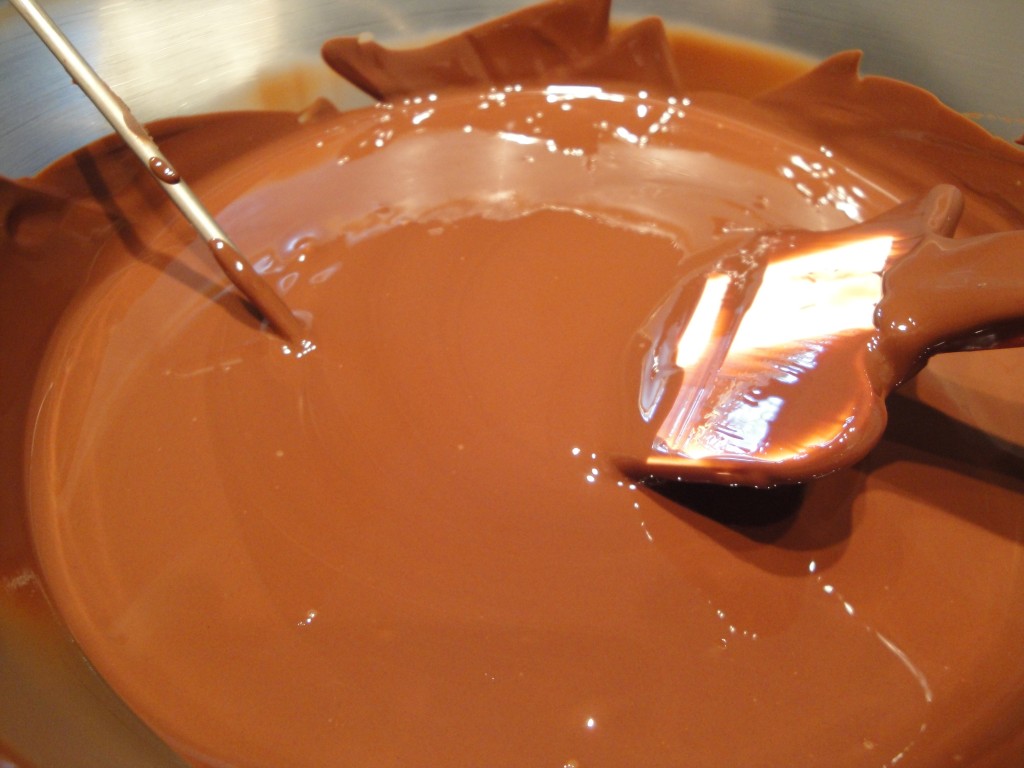
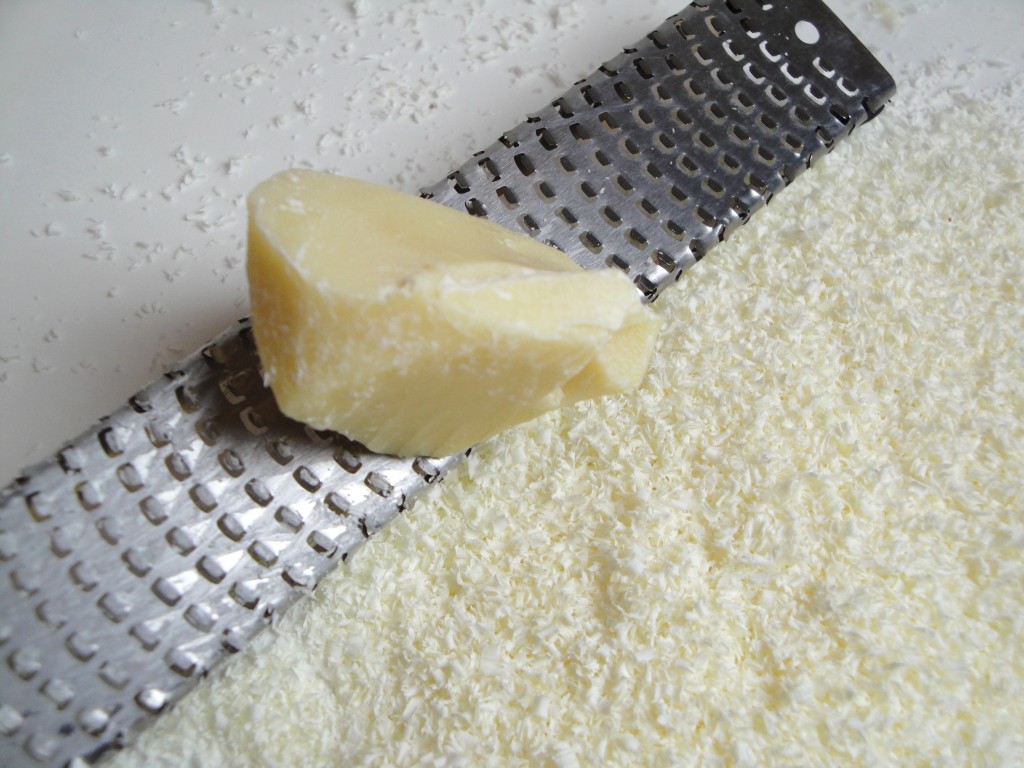
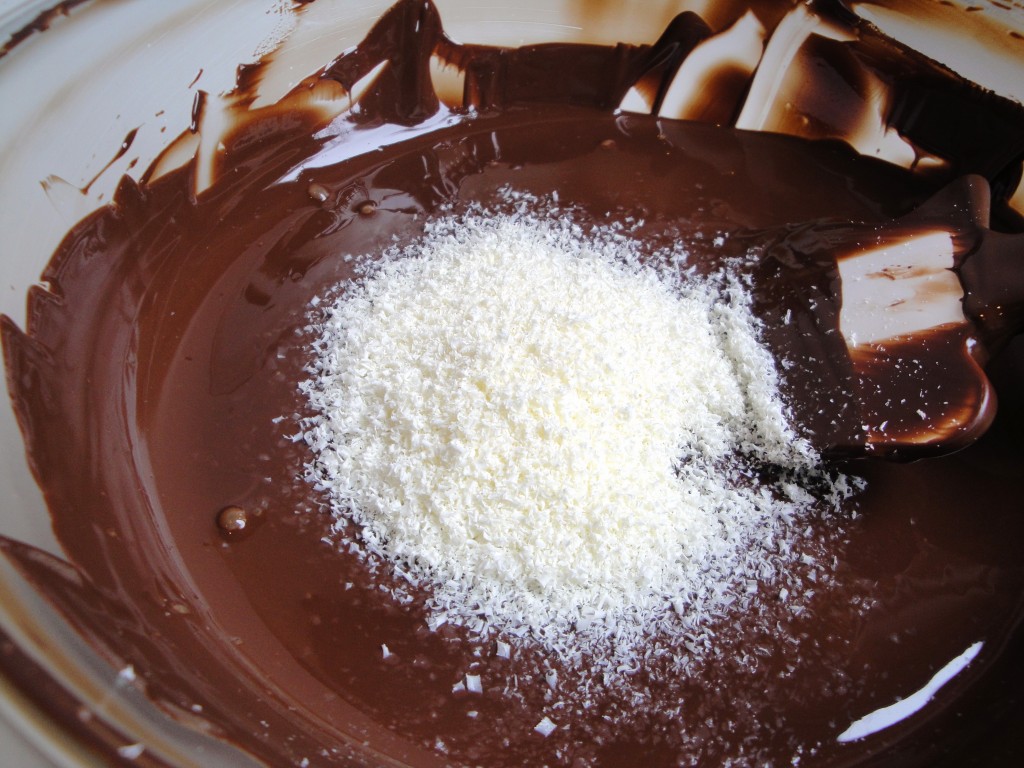


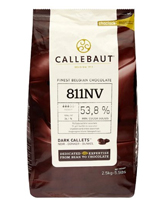

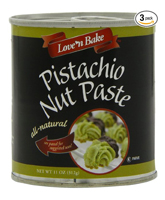

Hello Eddy: Although I am a professional Jazz Musician I have a great passion for cooking and now have been baking and making candies. I just found your site and blog and it has answered so many questions about “tempering.” I thank you so much for your sharing and this opportunity I have to learn from you.
I bought a box of 56% Signature semi sweet chocolate made by Chocoa. I got a recipe for Italian butter cookies that was spot on “Italian Bakery quality” from a Pastry Chef who runs her own bakery. I tempered the chocolate and dipped the finished cookies into the melted chocolate and truth be told the chocolate was too over powering. It did have a crack when it cooled so I know I had the chocolate tempered correctly.
So the question to you is: Am I using the correct chocolate and if so my answer is adding the cocoa butter that you describe here to thin the chocolate so it is not so heavy. Or……. should I be using a different chocolate and if so what do I want to use?
Hi Mark,
I was on Holiday and sorry for my late response. If the chocolate flavor overpowers the cookie you have a few options: 1) Purchase and use chocolate with lower cocoa mass content. 2) Purchase lower cocoa mass content chocolate and blend with your current one. 3) Blend your currant chocolate with some milk chocolate. 3) dip the cookie in less chocolate.
Having said that, the truth is that one company will make chocolate with a lets say 56% cocoa mass which is not very bitter while another brand will be more better. (Like coffee, 100% coffee beans is used in all brands, one turns out very mild while the other can be very bitter) Therefore the percentages are really just a guide.
Hope this helps and lots of success with your career!
Eddy.
Chef Eddy: thanks so much for your feedback and I hope you had a wonderful holiday !. If mix milk chocolate with my current chocolate semi-sweet couverture, I still need to temper it, correct? If I did a 50 / 50 mix how would I temper that?
Thanks very much for the suggestions. Next challenge, I’m going to attempt to make the puff pastry recipe that you have on this website.
Best Regards,
Mark Elf
The chocolate ganache is one of my favorites. Although I’m curious, after adding the cocoa butter at the wrong temperature will it begin to curdle?
Hi Chef
Thank you for all your great info! This method makes
Tempering so much easier. Especially in a hot bakery where it’s hard to get chocolate down to 25/26 degrees.
How do you re-temper left over chocolate. I’m guessing you don’t just keep adding cocoa butter?
Any help is greatly thanked.
Adam
I like the idea of mixing milk chocolate and dark chocolate together. it has a real nice flavor. Thanks for that idea Chef Eddy
Dear Chef Eddie,
Hello, I have been trying to make coloured chocolate easter eggs. So i coated the egg shaped mould with coloured cocoa butter and after it was set I casted it with tempered chocolate.
After leaving in fridge for several minutes I am having difficulty taking it out of the mould. And when it is coming out it does not come clean and shiny. Patches of coloured cocoa butter still get stuck to mould.
What am I doing wrong? Do i need to temper cocoa butter too when coating to mould?
thanks
Sankalp
Sankalp,
There a lot of moving parts when it comes to moulding chocolates or large pieces. Tempering your cocoa butter is a good idea. After you coated the molds with tempered cocoa butter (And do this quickly) and it has set, pour as quickly as possible the tempered chocolate into the mold. Having low humidity in your work space is a must and having a room temperature of about 19-21 C is perfect. However, try to have your molds at a slightly warmer temperature. You can use a hair dryer to get molds slightly warmer.
Hope this will help you out.
Eddy.
Chef Eddy,
Thank you so much for this guide – I look forward to giving it a try! I am planning to make some small chocolates for my wedding in a few months as a surprise for my to-be wife, but I only have small molds and will be making a dozen or so at a time! Would this method work even with smaller amounts of chocolate?
Thank you again!
Dear Chef Eddie,
thanks for your advice. It really helps. I do have another query though.
What is the best way to mix oil soluble powder colour into chocolate. I ended up having colour powder spots in the chocolate.
2. what is the best way to temper cocoa butter?
Thanks a lot for your help
Regards
Sankulp Sood
Sankulp,
Mix your fat soluble food color in a small amount of melted cocoa butter. If you do not have cocoa butter use a small amount of melted chocolate. Once combined add to the remaining melted chocolate and temper.
For tempering cocoa butter I use the seeding method. It works very good.
My best and keep your good work up!
Hi Eddy,
When you say “let the chocolate cool”, how do you do this process?
Thanks!!!!
Esteban
Esteban,
Sorry for my late reply. Simply allow to cool at room temperature.
My best, Eddy.
Hi Chef Eddy,
I noticed adams question was unanswered and I was thinking the same as him. I work in relatively small batches and there is usually chocolate left over. When we need to re-temper the chocolate for later use, do you just add more cocoa butter? If not then whats the process to re-temper the same batch, say a 2lb batch ad you used just around a pound and have a pound left over.
Hi there TJ,
What I recommend you do is spread your leftover chocolate on a sheet of plastic food wrap or parchment paper so it will cool and harden fast. Once firm cut in small pieces and store airtight. When you use this stored chocolate again simply melt dark chocolate to 115F (46C) and allow to cool to 95F (35C), add 1% microplaned cocoa butter and stir to dissolve cocoa butter. Let cool to 90F ( 29.5c) and you are ready to go. The reason TJ why we are adding cocoa butter in this method of tempering or crystallizing chocolate, is that adding coca butter at 95F (35C) forces the fat (cocoa butter) molecules to reconnect in a chain. So yes you do have to use 1 % cocoa butter each time you temper following this method. ( Anytime when we melt chocolate over 90F (29.5C) the chocolate molecules separate and we need to temper or re-crystallize them.)
My best with your chocolate work!
Eddy.
WOW when I learned about tempering chocolate I was amazed. It was so intresting to be to find out how the molecules seperate and how you have to bring them back together by adding the cocoa. NO wonder why everytime I made chocolate covered strawberries ;my chocolate would always melt off no matter how many times I dipped. Well let me tell you ….I tried it that same weeken of the week I learned that and my strawberries were FANTASTIC!
Chef Eddy,
On one of your other tempering posts you state to use 10% cocoa butter in the mix (using the ice bath method) And this one you have 1% cooling naturally. is it safe to assume that you did mean 1% but because of the room-cooling type method we needed less than the ice bath method?
Dear Eddy,
Thank you so much for kindly sharing you knowledge! I am a dedicated “seeding” temperer ~ but after trying your cocoa butter method today, I know I’ll never go back to seeding. The cocoa butter method is remarkably fast, and like seeding it’s very hygenic, which is a high priority for me in my business here in Thailand. I don’t understand why no one else teaches this method (or mentions it in their books) ~ the results were beautiful. Using a Microplane on the cocoa butter is a must, however ~ I first tried simply chopping the cocoa butter up quite fine, but it dissolved very, very slowly. The next time I used the Microplane with terrific results.
I look forward to you writing a book all about chocolates! Thanks again!
Laura
Does the cocoa butter make the chocolate sweeter?
Hello Chef, First let me say, I absolutely enjoy your blog and the information you impart. I have learned so much and I appreciate you. I am embarking on an endeavor to create delicious confections to share and have several ideas for fillings/flavors and presentations in mind. However, I’m having a bit of a trouble finding couverture. I know I can purchase it online, but I’m reluctant to do so without having personal knowledge of the flavors and undertones available. I have found a few offerings from various chocolatiers including origin and single source at my local market in the gourmet section. I am leaning toward the Callebaut but am unable to find out what the cocoa butter content is. There is nothing on the label and the employees have no clue. How much cocoa butter can I or should I safely add to ensure it is couverture quality? This Callebaut is in a huge block and pieces are broken off for sale. I’m interested in the dark or middle tones. I am told it’s a pure chocolate but no one there knows the term couverture.
Hi Candy,
Thank you for your kind comments. Go back to the store and ask if you can see the block of Callebaut in the original wrapper. You will see that underneath their name (on the front) their will be an image of “drops”. Callebaut identifies the “ease of melting – cocoa butter content” with drops. 1 drop = very difficult to melt and 5 super easy. (5 has more cocoa butter than 1 drop) If you see 3 drops it is certainly couverture with pretty good melting capability. If it only has 2 drops, melting will be harder, but you could add about 2-3% cocoa butter yourself and be at the same level of a 3-4 drop. Best of luck Candy!
Chef Eddy,
Thank you so very much for your response and best of luck sentiment! I really appreciate that you took the time and effort to assist me. You are tremendously generous with your knowledge and I am grateful. I will ask if I can see the original wrapper. I’m hoping it will be couverture. If not, I have found a source for food grade pure cocoa butter at the local health food store so I’m cautiously optimistic! Again thank you so very much for your kindness. Candy
Hi Chef,
You say “Even though 1% of cocoa butter will properly pre- crystallize the couverture, adding more will not have any negative effects on the finished products. In fact, adding a little more will allow you to use the tempered chocolate at a higher temperature.” I want to thin my chocolate a lot so I can dip freeze dried products and then subsequently pan them. I need a very thin coating simply to hold the centre together. Being extreme, what would happen if I used say 30% cocoa butter instead of 1%? Is that taking it too far?
Thanks!
Colin 🙂
Colin, the chocolate shell may crack in the freezer with that much cocoa butter. Is adding a small amount of oil (grapeseed, peanut) out of the possibilities? This would prevent cracking and still make it very fluid AND set in the freezer. Adding 10% oil to melted or tempered chocolate will make it nicely fluid. Give it a try and see if you like the results.
My best, Eddy.
Thanks so very much for this Eddy. I am very cautious of allergies so I won’t try peanut but grapeseed seems a possibility. I don’t need the product to be refrigerated or frozen so cracking in the freezer is not a problem. But grapeseed seems a LOT less costly than cocoa butter! (I am using Mycryo). The entire process is to pre-coat freeze dried strawberries so the stay together and then I pan then carefully with chocolate. It has worked well for milk and dark and now I am trying white. (A description of the finished product is at https://www.captaincoffee.com.au/chocolate-delights/ and https://www.captainchocolate.com.au/chocolate-delights/ ) I need the pre-coat to be very fluid so as to get a nice cover but without a “foot” as the chocolate sets prior to panning. But it also needs to be nice and hard when set so I can pan. You have some REALLY good ideas and thoughts on your blog. Thanks so much! Colin 🙂
Colin,
I read your previous note EARLY in the morning before coffee…. saw freeze dried and assumed you were going to freeze them! On Mycryo, I am not sure how well you like it in Australia but in humid Texas it does not always wants to melt properly. What I do instead (with 100% great results) is temper pure cocoa butter – any method will work. Once tempered pour it about 1 cm thick into a mold of some sort. Once hardened store in plastic and when needed, use a microplane zester to grate into superfine particles. Use the same way you would mycryo. Far less costly and works super!
By the way, your web site and products look great.
Eddy.
Your ideas have been a real eye-opener for me Eddy! I have stocks of Mycryo so I will use them up and will order some Callebut cocoa butter and use your thoughts. We had some really hot days here (Sydney) and I didn’t realise that Mycryo needed to be so well protected and I fear that I let it get warm and it may have lost its temper – hence I suspect that I can’t use it for your methods. It’s now stored in my chocolate room at 20C. You have given me much to play with!
Thanks for your comments about my web sites! I am 100% self taught with chocolate – I was a consultant in Exhibition Marketing (www.bestofshow.com) and the GFC meant that I needed to do something else. It’s working out – slowly! Hence my deep appreciation for your insights
Colin 🙂
Hello Chef Eddy,
I have problem with my croissants. They keep tearing in the middle while it is proofing and also it has air pockets. Please help me. Thank you.
Chef Eddy,
I have used your cocoa butter method of tempering once, with success. I was using some milk chocolate that refused to temper and, when poured into molds, refused to come out and was streaked–all the usual signs. So I used that same chocolate (once I got it out of the molds) with the cocoa butter method, and it came out perfectly–dropped out of the molds without any effort at all. My question: Why does 1% of cocoa butter work when other methods of seeding call for using a much larger percentage of already-tempered chocolate? I see that one difference is that you call for waiting until the temp drops, whereas with the usual method, one starts adding seed chocolate as soon as the chocolate is melted. I would like to understand your method and why it works so easily. Thanks for any information.
I am not a chocolate fan, but I always wanted to learn how to temper chocolate. No I’m dipping strawberries.
I have been trying to find info about mixing different couverture chocolates, such as milk, bittersweet and semi sweet,
can I mix my three different wafer chocolates (Callebaut couvertures) in one bowl and temper them at the same time or do I need to do them all separately and then incorporate them once tempered?
Any info would be greatly appreciated,
Thank you,
Mattias
Mattias, you certainly can mix couvertures and then proceed to temper them as one unit. Oftentimes I add dark couverture to milk couverture to make the latter less sweet. My best!
Eddy.
Chef Eddy,
i like you spin on a known cocoa butter product that is out on the market!!
Ray
I have done this on you class more than 3 times one thing is that some time the coca butter doesn’t melt making the finish product with white spots or sometimes. Plumping , but now I use the microwave to get those final coca butter to melt .
In your plated desserts class was the first time of hearing about the cocoa butter method. At first I did not fully understand the purpose of the cocoa butter method. However I noticed a difference in the texture of the chocolate, it is always smoother to me. Using this method makes me feel like a pro.
Hi Chef,
I saw a recipe adding pre- crystallized cocoa butter to a mixture of white chocolate +cream,sorbitol,passion fruit purée and butter.
My first question is how to just pre-crystallized cocoa butter?
My second question is can I left out sorbitol ?
Thanks!
Cheers,
Elizabeth
When you first showed us this method I was pretty confused. I’m sure you could tell. But after you came up to me and actually explained it to me again I got it. I just needed a little bit of a reminder. Thank you for having the patients and the time to help me out.
I love the cocoa butter method, by far the easiest! It’s absolutely great for dipping chocolate due to the fluidity!
Hello Eddy,
Very appreciative of all your work and your site! A Godsend to the pastry world!
Question:
Can the cocoa butter itself go out of temper? The cocoa butter that you are using-hasn’t that been per-crystallized to have the proper crystals already? The reason I ask is that if I go through a mail order source(for home experimentation) what happens if the block of cocoa butter is subjected to varying(non-preferential)chocolate storing temperatures?
Thank you so much!
Rachel
My apologies, I went through the thread to realize that you do in fact pre-crystallize the cocoa butter itself properly. Thank You!